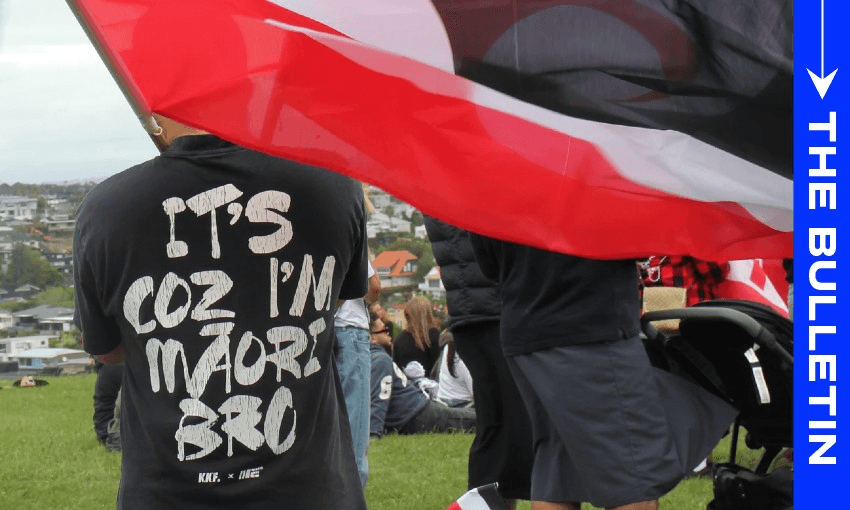Thousands converged on Auckland, the day before the first reading of the controversial Treaty Principles Bill, writes Stewart Sowman-Lund for The Bulletin.
To receive The Bulletin in full each weekday, sign up here.
Auckland’s wobbly bridge welcomes hīkoi
Thousands of protesters converged on Auckland yesterday, crossing the harbour bridge before splitting into two groups: one headed to Bastion Point, the other to Ihumātao. Extraordinary drone footage shared by the Herald illustrates the size of the Hīkoi mō te Tiriti, which is only expected to grow in the coming days. The Spinoff’s Lyric Waiwiri-Smith was among the group and described the mood as the protest made its way across the wobbling harbour bridge.
Here’s Lyric:
If you looked at your feet or the barrier between the bridge’s outer and inner lanes, you could see the ground beneath you move. So it felt better to look at the signs around instead: “Kill the bill”, “whaka round, find out”, “Seymour, say less”.
There were also the constant honks from the hundreds of cars that passed us. Many waved the tino rangatiratanga flag, others stuck out their thumbs and some threw a mana wave, which were always enthusiastically returned. They represented the many people who clearly support the kaupapa, but thanks to the responsibilities of work, family and, generally, life, their presence was needed somewhere else.
Today, the hīkoi heads to Hamilton. It will arrive in the capital on November 19.
A new generation
On the latest episode of The Spinoff’s politics podcast, Gone by Lunchtime, co-host Anabelle Lee-Mather noted how the hīkoi had resonated with a new, younger generation of activists and supporters. “The messaging, I think is really resonating with rangatahi, with kaumātua, with tangata tiriti. And I like that the message that’s coming through is about… protection of the treaty, kotahitanga, unifying Aotearoa, all of those things. So it’s impressive to watch.”
The consequence of attracting a younger generation is that school-age children want to attend. Some schools, criticised David Farrar for Kiwiblog, have encouraged or endorsed their students attending the hīkoi when it makes its way through their town. Act leader and associate education minister David Seymour warned school principals against allowing this, telling Newstalk ZB’s Heather du Plessis-Allan that it was more important for children to be in the classroom than marching the streets. “Principals are public servants required to show political neutrality,” he warned.
While the hīkoi is still making its way down through the top of the country, other parts of Aotearoa joined in support as well, reported The Spinoff’s Alex Casey from Christchurch. At least a thousand supporters turned out at the Bridge of Remembrance, signs at the ready.
Here’s Alex:
As speakers continued to take the stage, that idea of unity shone through. Everyone was invited to have a little mihi with the stranger next to them, and thank them for coming. I chatted to Shavaughn, t-shirt emblazoned with the flag of the United Tribes of New Zealand, whose daughter was there to sing waiata onstage with her roopu from Te Kura Whakapūmau. “I’m standing right here because I’ve got a direct line to seeing her,” she beamed.
Treaty Bill set for first reading
Obviously, the main impetus for this nationwide protest is the government’s Treaty Principles Bill. It’s set to have its first reading in parliament later today, or, as RNZ’s Anneke Smith described it – today is D Day for the Treaty Bill. As if the political headache over the bill couldn’t get more intense, a group of 42 prominent kings counsel have now joined public opposition to the bill, reported Thomas Manch. In a letter addressed to the prime minister and attorney-general, the lawyers argued the bill would “have the effect of unilaterally changing the meaning of te Tiriti and its effect in law, without the agreement of Māori as the Treaty partner”.
One person who won’t be present for this afternoon’s debate is prime minister Christopher Luxon, who has maintained his opposition to the bill while reiterating that, as per the coalition agreement, his party’s MPs will vote for it at first reading only. Luxon has headed to the Apec leaders meeting in Peru – timing that the Herald’s Claire Trevett (paywalled) suggested was more than coincidental. On Monday, reported Stuff, the prime minister issued arguably his strongest condemnation yet of the bill, saying it was “divisive” and a “very simplistic interpretation of the Treaty of Waitangi”.
Not everyone is convinced the government will indeed kill the bill after first reading, reported Te Ao Māori News, with one protester telling the outlet it was “lip service” and questioning whether Luxon may choose to hide behind the other “two heads of the taniwha”.
‘Media bias’?
The bill’s architect, David Seymour, has taken issue with his proposed law being described as “divisive” – but has seemingly stayed silent on his boss’s decision to label the bill that way. In an email to supporters yesterday to drum up support, Seymour claimed “media bias” after TVNZ Breakfast host Jenny-May Clarkson called the bill divisive at the start of an interview earlier in the week. “After we introduced the Treaty Principles Bill into parliament last week, the media seems to have had something of a collective meltdown,” the supporter email said.
Act and Seymour have shared the interview several times online in recent days. As Newsroom’s Tim Murphy noted on Twitter, “Act still thinks ‘divisive’ is a media word, from a vocal minority”. The days ahead may reveal who is right.
